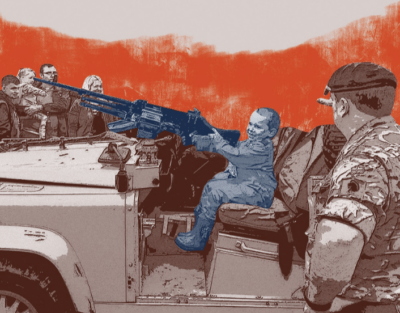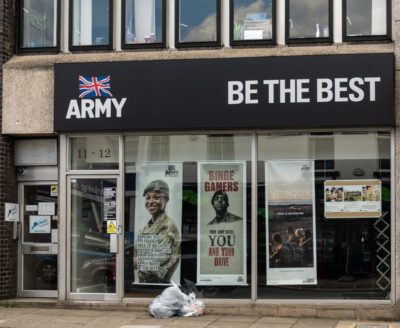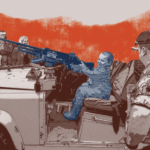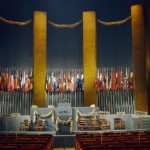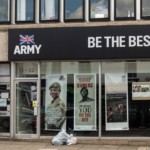The Military-Entertainment Complex

War films populated our video collection as a child. My dad would watch them regularly. Oliver Stone’s Platoon was a favourite. Hamburger Hill, another, more down-market Vietnam movie, featured prominently. Heartbreak Ridge, which had a grizzled Clint Eastwood whip a group of errant marines into shape in time for the US invasion of Grenada, was virtually always on. Iron Eagle, a slightly budget Top Gun substitute with a powerful coming of age narrative, was wheeled out occasionally. And of course Top Gun itself, which would often be playing on a Sunday.
I was born in 1982 and watched these films during the early 90s. None of these movies were remotely political artifacts for me at that time. They were simply stories, and exciting ones at that, absorbed without any acute judgment at all. Three decades on I am far better informed. And with a long-awaited sequel to Top Gun in cinemas, it is worth examining both the implications of militarism in movies and why military intervention in culture is so prevalent.
The second coming of Maverick
Released in 1986, Top Gun was an action-packed Cold War story which centred US naval aviators and provided a vehicle for Tom Cruise, Val Kilmer and Meg Ryan to launch their Hollywood careers. Its treacly patriotism and impressive aerial sequences landed with audiences across the world, earning it an Oscar, four Academy nominations and over $359m at the box office. The sequel, Top Gun: Maverick, was released in 2022 and is already making waves. Millennial nostalgia is clearly a part of this, but so is a new militarism.
The latter point is an important one, because both Top Gun films seem to be part of a re-conditioning of western militarism in the context of failed wars overseas: re-conditionings in which Hollywood and the military industrial complex have combined powerfully to offset public distaste for military adventures. Although, some commentators juxtapose the mid-80s release of the original Top Gun – 11 years after the Vietnam War ended – with that of the sequal, where the debacle of Aghanistan is still fresh in the mind of audiences of all ages.
Recruitment is also a salient feature, not simply of the literal joiner but of the population at large. Top Gun supposedly helped sign-up rates balloon by a whopping 500% in 12 months – aided by the US Navy’s decision to set up recruitment stands inside cinema foyers after the film’s release. This potential is what led anti-war actor Matthew Modine to turn down the role of Maverick and go on to play Joker in Full Metal Jacket instead. Reports from the US suggest recruitment stalls also started popping up in large numbers following the release of Top Gun: Maverick. Beyond an increased interest in joining-up, the original laid the groundwork for the detatched representation of the first Gulf War as a bloodless conflict fought surgically from the air – a spectical to be watched with awe as opposed to the horrors of Vietnam.
One of the most notable analyses of the military-industrial-entertainment complex was formulated by American journalist Nick Turse. His book, The Complex: How the Military Invades Our Everyday Lives, is a tour de force on the topic. In an excerpt published on the US website TomDispatch he sifts through the Hollywood projects that enjoyed military support and examines the terms under which it is offered.
Some, such as John Wayne’s The Green Beret’s or Ridley Scott’s Black Hawk Down, are well known. Others may be more surprising: the Transformers franchise, Star Trek IV and The Towering Inferno. It is also well known that the Marvel franchise is deeply entangled with the Pentagon, though there has been occasional conflict over scripting. In his article Turse leans on another scholar of the topic, David Robb, to encapsulate this relationship:
‘Hollywood and the Pentagon have a collaboration that works well for both sides. Hollywood producers get what they want — access to billions of dollars worth of military hardware and equipment — tanks, jet fighters, nuclear submarines and aircraft carriers — and the military gets what it wants — films that portray the military in a positive light; films that help the services in their recruiting efforts.‘
The US Air Force even has its own Entertainment Liaison Office in Hollywood. The office’s Director, Lieutenant Colonel Glen Roberts, says its purpose is to ensure the entertainment industry has “access to Airmen, bases and equipment if [it] meet certain standards set by the Department of Defense.” If Top Gun: Maverick is anything to go by, this includes allowing DoD representatives to view the rough cut and confirm “that the tone of the military sequences substantially conforms to the agreed script treatment, or narrative description.” And in case you were wondering, the Pentagon can request removal of any compromising material.
Or they could just pull out all together. The Hurt Locker was originally given DoD support, but this was retracted after officials felt that additional scenes had gone off the agreed script. Their beef: that soldiers were portrayed unflatteringly, according to some reports. A scene which showed detainee abuse caused rancour with military advisers. Journalist Mark Boal, whose experiences of embedding with a bomb squad formed the basis of the script, said that other classic war films with a critical edge had been treated similarly:
‘The Department of Defense did not support the movie. And my understanding is that they did not support Platoon or The Deer Hunter. I am OK with that outcome because I didn’t want to change the script to suit them.’
RMA
As early as 2003, scholars were locating their investigations of the military entertainment-complex in the Revolution in Military Affairs (RMA). RMA describes a form of warfare in which the military instrumentalized emerging and existing forms of media: for example making them an extension of the battlefield. As academics Stephen Stockwell and Adam Muir have argued:
‘Now there is a new force in the land, the military-entertainment complex evident in the close co-operation – and sharing – of ideas and resources: between computer games producers and the military, particularly on pre-training prospective candidates for the US armed forces; between Hollywood producers and the US government on language and concepts post September 11, 2001; and between the military’s propaganda machine and the entertainment industry’s thirst for manufactured and timely “reality” that precludes the possibility of the critical representation of the real’.
Clearly Top Gun proves the military was using movies to propagandise prior to 9/11 – though perhaps not on the same scale and sophistication, or with the same reach, as current technologies allow.
Commander Bond
The Top Gun movies were made decades apart. In between that time there has been a steady churn of Hollywood films the scripts of which have garnered military support. British cultural icons like James Bond, whose films land every few years, have always had a strong association with the military. Bond is, after all, Commander Bond, a Royal Navy veteran turned spy. And military hardware took a central role in the most recent movie, No Time to Die, with a Royal Navy ship central to the percussive denouement.
This was also reflected in real life, or at least in a sort of liminal space between the franchise and reality. The head of the military, Admiral Tony Radakin, performatively promoted Daniel Craig at a ceremony on the Thames ahead of the film’s Covid-delayed launch in September 2021. Craig said he was proud of his association with the Royal Navy in a press release which talked up the presence of a range of military equipment in the movie and its trailer:
‘As well as HMS Dragon making an appearance, the Royal Air Force also granted access to key assets and personnel. RAF Brize Norton, in Oxfordshire, was used as a backdrop in the film, standing in for a NATO airbase in Norway where Bond joins MI6 allies and later boards a C-17 Globemaster. Meanwhile, the Army supplied troops from the Household Cavalry. They offered their time at a pivotal moment in their calendar, just before the Changing of the Guard at Buckingham Palace.’
Not wanting to miss out on a PR opportunity, the RAF looked to send a pilot to the UK premier of Top Gun: Maverick, telling The Sun that it wanted to use the film as a “recruitment inspiration moment”. Details of UK military involvment akin to the Pentagon’s presence in Hollywood, and other cultural projects generally, are harder to pin down, but the MOD does offer filming locations including in barracks and ships.
Nostalgia
With strike waves across the country, Kate Bush in the charts and Top Gun in the cinema, there are powerful nostalgias at large in Britain today. I’m keenly aware that as a kid watching war movies as diverse in their politics as Platoon and Top Gun, but without the complex critical facilities I may have today, much slipped beneath the radar. And it was not just that I couldn’t distinguish which films had passed the respectability tests of military advisers. There was no way to tell which ones has not enjoyed the support of the Pentagon.
The term “culture war” is generally used to describe a different process entirely these days. But there is a war in culture itself, in which different ideas about the military and human conflict itself are projected out onto the consuming public. A public which in many cases, I will at least anecdotally assume, may not be well positioned to separate that which is pro-military from that which is meaningfully critical.
See more: militainment, recruitment, culture
Like what you read?
> Sign up for our newsletter or blog notifications
> Support our work – from just £2 a month

